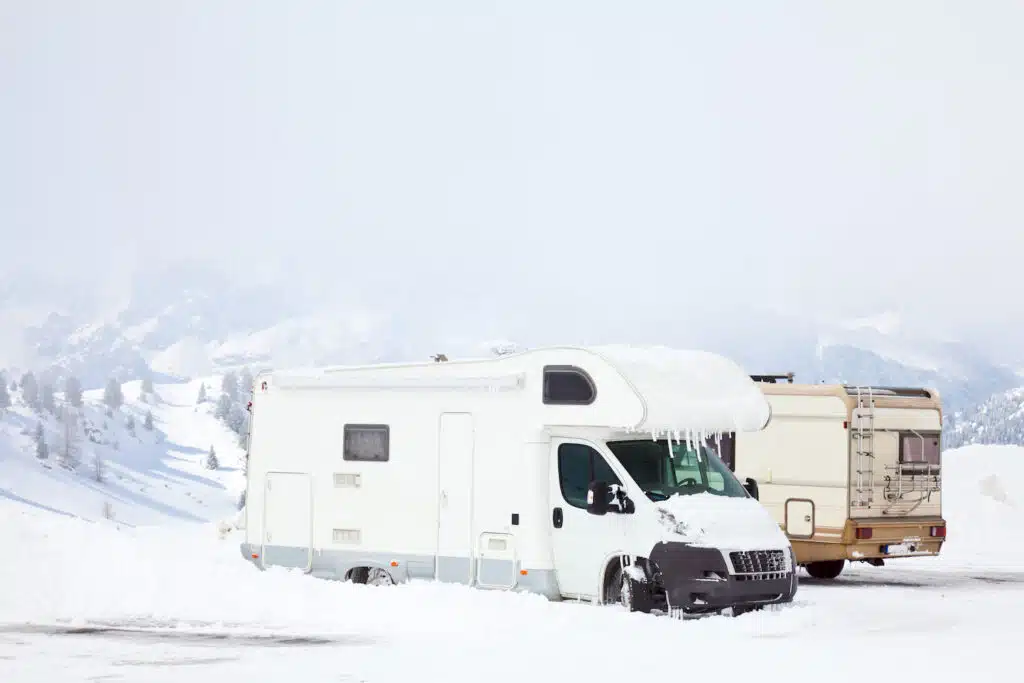Winter camping is gaining in popularity, as RVers realize that there are less crowds and more availability at campgrounds during the winter. However, your fifth wheel, travel trailer or motorhome can get quite cold with blowing winds, snow and ice.
RV winter skirting is the smart way to stay warm and protect your camper from the harsh weather elements.
We know firsthand how miserable an RV can be in the winter time without proper insulation.
The windows sweat with condensation, creating a more humid and damp atmosphere inside. Which means you need to find smart ways to stay warm in an RV.
The plumbing and sewer pipes and water storage tanks need to be protected from freezing, otherwise you won’t have any running water, toilets or ability to flush sewage out of your rig.
The cost of winter camping can be huge, too, as you use a lot more propane to keep you and your trailer warm.

Winter skirting helps to protect your RV and keeps you happier, too, in the winter months. This smart investment will save you money and hassle during cold temperatures.
However, there are a variety of ways to insulate your rig, and they can range from a few hundred dollars to close to $5,000. You will want to choose what works best for your situation and how frequently you plan to camp in below freezing temperatures.
Helpful Tip: Many of these RV skirting solutions can be used in hot summer months, as well, to keep your RV cooler. This is helpful if you are parked for a while in one place.
What is RV Winter Skirting?
RV winter skirting is a piece of material that wraps around the bottom of your trailer or motorhome. The purpose of RV winter skirting is to help insulate your camper to keep you warm, protect your plumbing and save on heating costs.
In order to work, RV winter skirting needs to cover the bottom of your camper completely. By protecting the underside of your trailer, you will reduce the cold air getting to your plumbing, which could cause the pipes to freeze.
You will also reduce the cold air and drafts underneath your rig which can cause the interior to be uncomfortably cold. Overall, it helps campers control the temperature of their RV and prevents the underside from freezing.
When shopping around for RV winter skirting, you’ll come across a lot of different designs. RV winter skirting ranges from expensive custom skirting, which is guaranteed to fit correctly and last a long time, to low-budget DIY solutions like vinyl or foam boards.
In a pinch, you can even pile up snow around the bottom of your camper to act as skirting!
Does RV Winter Skirting Work?
RV winter skirting is a low-tech solution that works as long as you install it properly. Any added insulation is sure to keep you and your camper warmer.
Another reason to add RV winter skirting to your motorhome is to save a lot of money on your propane bill.
In addition to improving your comfort while camping, RV skirting is vital to protect your sewer pipes and water tank from freezing over in temperatures below freezing.
If you are parking your trailer or motorhome for a while during cold weather, winter skirting will also help protect your tires. If you don’t move the RV and the tires sit stationary, they could develop dry rot or sidewall cracking. Dry rot can also develop from the UV rays of the sun. By covering the tires, you’re protecting them from UV rays, which will stop them from developing dry rot as quickly. Which extends the life of your tires.
How do I Install RV Winter Skirting?
RV winter skirting is relatively straightforward to install but requires your full attention. You will need to pay close attention during installation and measure correctly as any gaps in the material you choose will reduce the effectiveness of the skirting.
Attaching RV winter skirting requires you to secure the material to the bottom edge of your RV, covering every side and having the material extend to touch the ground. Any gaps will ruin the purpose of the skirting, so doubling up and taping over cracks will be necessary for the skirting to work correctly.
If you buy custom-built skirting, it will usually come with attachment tools like Velcro or clips.
If you are using a DIY solution, you’ll want to use something like adhesive tape to secure the material. Be sure to use a cold weather tape as it is durable, water-resistant, and easy to remove.
The material you are using as your RV winter skirting will also make a difference as to how you secure it. For example, foam boards are very light and may blow away in strong winds if not attached correctly.
What Should I Use as Winter Skirting for My RV?
Now you know the purpose of RV winter skirting and if it works, you might be wondering which materials make the best winter skirting. Here are a few of the best materials to use as winter skirting on your RV.
Insulated Foam
Insulated foam boards are one of the most affordable and easy-to-install RV skirting materials around. You could also use flexible insulated sheets, although rigid boards are easier to attach and cut into shape. You just need to measure out your boards and tape them on securely. You can also use flexible insulated sheets to help cover any gaps for added insulation.
You will be using a lot of foam boards. If you plan on traveling during the winter and needing to reuse this DIY winter skirting, you will need to transport these boards. Get an idea of where you can store them. Will they fit inside your trailer or motorhome or tow vehicle? If not, are you willing and able to buy new foam when you get to your next destination? And how will you store or dispose of these foam boards when winter is over?
Here is an excellent tutorial on how to install DIY RV Skirting using insulated foam boards. The cost was around $250 for this fifth wheel winter skirting.
Vinyl
Vinyl is another popular material to use when making RV winter skirting. It’s the easiest material to cut to the correct shape, and its weight makes it easy to handle and attach.
You can also attach vinyl in a variety of different ways, whether you use suction cups or Velcro.
A downside to vinyl is that it doesn’t provide as much insulation as insulated foam sheets and boards. However, it is easier to fold up and store or transport.
Plywood
If you are short on time and looking for the cheapest possible option, plywood will also work as winter skirting. The main benefits of using plywood are its durability, it can be bought at any hardware store, and it can be reused in a variety of ways after winter.
The downsides to using plywood as winter skirting are it doesn’t provide excellent insulation and can be difficult to install. That being said, if you are stuck for options and don’t mind a bit of manual labor, plywood will work better than nothing.
Hay Bales
We’ve seen people using hay bales under their trailer for insulation, and they do work! That is why you can actually use hay bales to insulate earthen homes, too.
However, critters and rodents do like to nest in hay bales. And you certainly don’t want to cause a mice problem in your trailer because you used the wrong DIY winter skirting. Mice can chew through wires, creating costly repairs.
If you have no other options, then hay bales can work.
EZ Snap
If you don’t want a DIY project, then check out EZ Snap. This company produces high-quality purpose-made RV skirting that can be cut to fit on any size RV.
You can choose from either adhesive or drill studs to install the skirting. Just pick the recommended kit for your RV and then cut down and cut the size of the vinyl tarps accordingly. Installation requires only a couple of tools, and EZ Snap provides several tutorials to make the installation simple.
Here’s a real-life example of using EZ Snap RV skirting.
AirSkirts
If all of the other winter skirting options sound too complicated or require too much labor, you might enjoy using AirSkirts to protect your vehicle from winter weather. These inflatable tubes fit underneath your camper to fill in the entire space between the ground and the underbelly of your RV, sealing in the air to create natural insulation. They require no modifications to your vehicle and easily install in under 20 minutes.
Tire wedges and step insulation tubes are also available to seal every single gap that might allow cold air intrusion underneath your motorhome, fifth wheel or travel trailer or tiny home. Because of the tight fit, AirSkirts states that the product is up to 75% more effective than traditional skirts for winter.
Airskirts come with the pump to inflate them. The pre-measured kits make it easy to get exactly what is required for your RV. No stressing about needing to take a lot of measurements. The skirts deflate to store in a bag for easy travel.
There is no need to modify your RV with snaps, clips or rails with this system. And you won’t need a professional installer to add the system to your rig. Plus, this winter weather protection is much more visually appealing than having boards or vinyl taped around your home on wheels.
Want more winter camping tips? Here’s the best safe tent heaters to prevent a winter chill while tent camping. And here are some great tips on how to insulate a tent for winter camping.

John Wedell
Wednesday 2nd of February 2022
What do you do about the humidity build up under the rv. Mine is skirted with 1 inch foam board and the humidity is 99%.
Couch Potato Camping
Saturday 19th of February 2022
To be honest, we typically don't stay in one location long enough to warrant us addressing humidity buildup under the trailer. However, we do carry a portable dehumidifier to address humidity within the trailer when we are in locations where humidity will be an issue, i.e. the Deep South, the Northwest, etc.
Couch Potato Camping
Sunday 6th of February 2022
We don't have a great answer for that, other than to allow some air circulation. Which, of course, would increase the cold underneath.